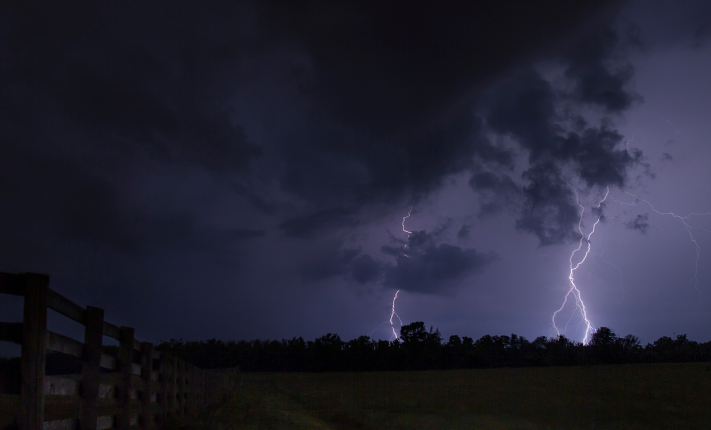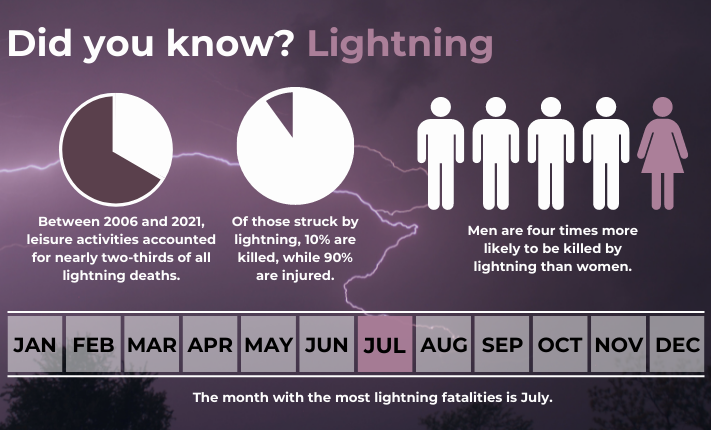Posted by Weatherflow ● September, 2022
What to Do When Lightning Strikes

Lightning kills an average of 20 people and injures hundreds more annually. It can heat the air to 50,000º F (27,760º C) and pack 300 million volts. These numbers alone should scare a person, but every year people are outside during thunderstorms. For example, watch a baseball or football game during a storm: you’ll see players clear the field, warning messages display on video boards, and yet the stands remain full of spectators. This same pattern can be seen during many outdoor recreational activities.
As of early August 2022, the National Weather Service recorded 22 deaths due to lightning for the year. Reviewing what people were doing when struck shows they were all enjoying outdoor activities such as walking their dogs, mowing the lawn, camping, and other similar tasks. None expected lightning to hit exactly where they were; unfortunately, none sought shelter.
SPORTS AND LIGHTNING
- Florida, April 2022: Leaving a Major League Baseball spring training game, two people were injured when they were struck by lightning. The game had been called in the 6th inning due to a thunderstorm.
- Bulgaria, August 2021: Soon after a soccer game started, the coach was struck and killed by lightning; other injuries also occurred.
- Pennsylvania, July 2021: While attempting to seek shelter, a 71-year-old golfer was struck by lightning and died on the course.
- New Jersey, June 2021: A 70-year-old golfer was found unconscious and not breathing near the 7th Hole. He was pronounced dead due to a lightning strike.
FISHING, BOATING, AND THUNDERSTORMS
- North Carolina, July 2022: A 33-year-old man was struck by lightning while boating during a thunderstorm. Sheriff deputies attempted resuscitation for 20 minutes before the man was confirmed dead.
- Quebec, June 2022: During a fishing trip, lightning struck a truck and arced through the nearby area, injuring four people and damaging 15 vehicles. The most severe injury was to a man taking a shower in his trailer.
EVERYDAY OUTDOOR INCIDENTS
- Washington, D.C., August 2022: Three people died, and a fourth was hospitalized after lightning struck during a severe thunderstorm warning. In Layfayette Square, near the White House, the lightning strike was witnessed by Secret Service officers who attempted to help the victims before paramedics arrived.
- Florida, July 2022: While mowing for a landscaping company, a 27-year-old man was knocked unconscious after a nearby palm tree was struck by lightning. He spent a week on life support before succumbing to his injuries.
- California, June 2022: During an early morning thunderstorm, a woman walking her two dogs was struck and killed by lightning. Deaths like this are rare in California, but this storm produced thousands of bolts.
STATISTICS OF LIGHTNING
Between 2006 and 2021, leisure activities accounted for nearly two-thirds of all lightning deaths. Statistics also show that men are four times more likely to be killed by lightning than women. The month with the most lightning fatalities is July. Strikes fall into four categories; direct strike, side splash, contact injury, and ground current. However, of those struck by lightning, 10% are killed, while 90% are injured. Survivors are often left with burns, cataracts, seizures, hearing loss, and neurological symptoms. Some of these injuries can be life-long.

WHERE TO SEEK SHELTER
So, where should you seek shelter if you’re caught outside during a thunderstorm? The best thing you can do is to check the forecast and see if storms are expected. If so, you should reschedule your outdoor plans. However, inside buildings and vehicles are the best places to seek shelter if caught outside. The worst places to shelter are in the water or under trees.
- If at an organized sporting event or stadium concert, listen to instructions on where to go. Leave the stands and avoid standing near any tall poles.
- When playing golf and out in the open, put down your golf clubs, remove your golf cleats, and crouch down near the ground.
- If you’re on open water and begin to see distant lightning or hear thunder, head back to land as quickly as possible and seek shelter at least 100 yards away from the shore. If you can’t get to shore but have a cabin onboard, seek shelter inside and away from any metal.
- While hiking, get down from elevated areas. Do not seek shelter near trees, ponds, or barbed wire fences, which can all conduct electricity. Remove metal framed backpacks. Don’t hide under overhangs; if near a large cave, go inside. Next, find an open space, a valley if possible, and crouch while covering your ears, but don’t lie flat on the ground.
The National Weather Service often uses the phrase, “When thunder roars, go indoors!” There are a variety of apps that can alert you when severe weather is in the area, as well as others that can alert you when lightning is nearby. Use these resources to stay aware of thunderstorm activity before lightning strikes.
Did you know? The Tempest Weather app, when combined with your Tempest Weather System, can alert you when lightning approaches your immediate location. Don’t have a Tempest Weather System, but want to spend time outdoors safely? Keep an eye on the sky with one of these popular apps:
WeatherBug: Spark Lightning Alerts
Carrot Weather: Premium Ultra Membership provides rain, lightning, and storm cell notifications.
The Weather Channel: Premium Membership provides an enhanced lightning map with a 30-mile alert radius.
Back to: Articles, Extreme Weather

